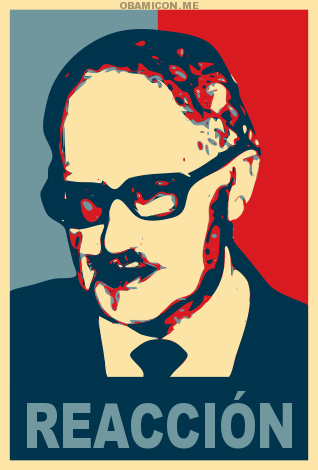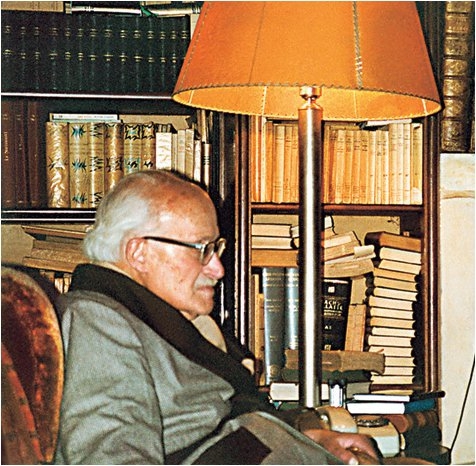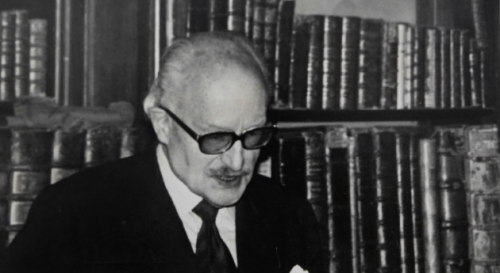There are two purposes for this article. The first is to introduce the ideas of Nicolás Gómez Dávila to the English-speaking American and European Right. The second is to motivate a more profound approach to his works, in their original Spanish editions and in Italian and German translations. (Sadly, the English translation is deficient.)
His Life
Colombia, like most South American countries, is a state with a high level of miscegenation; we can safely say that less than 15% of the total population could be considered white. This group includes mostly descendants of white Spaniards and descendants of other Europeans, like Italians and Germans, who chose to settle in Colombia instead of migrating to countries with more European population like Argentina or Chile.
This small white population usually — but not always — occupies the upper economic and social levels of Colombian society. The ones who don’t belong to these levels can be found in Colombia’s southwest and central small towns. Needless to say, this white population is not racially conscious, and they are marrying and procreating with non-whites prolifically.
Nicolás Gómez Dávila was born on May 18, 1913, in the city of Bogota, into a white family that belonged to the upper socio-economic levels of the city. He was a descendant of Antonio Nariño, one of the white leaders of the independence movement in Colombia (then known as Nueva Granada). When he was six years old his family moved to Paris, where he studied in a Benedictine school until a severe case of pneumonia forced him to be home schooled with private tutors. He obtained a solid classic education by learning classic languages (Latin and Greek) and modern languages (English, French, and German). When he was 23 years old he came back to Bogota, married, and never left the country again (with the exception of a six months stay in Europe), until his death in May 17, 1994.
He spent his whole life in a voluntary seclusion inside his home library, surrounded by a collection of more than 30,000 volumes, where he employed his time reading and writing. The Italian Franco Volpi, one of the most devout promoters of Gómez Dávila’s thought in Europe, condensed his life in this sentence: “Nació, escribió, murió”[1] (Born, Wrote, Died).
His Works
 Almost all of Gómez Dávila’s writings are collections of aphorisms called — in Spanish — Escolios. Escolios comes from the Greek scholión, which literally means commentary. This term was used in old manuscripts for commentaries made between the lines by someone other than the original author of the text. These escolios have been compiled into his main works: Escolios a un Texto Implícito I, Escolios a un Texto Implícito II, Nuevos Escolios a un Texto Implícito I, Nuevos Escolios a un Texto Implícito II, and Sucesivos Escolios a un Texto Implícito.
Almost all of Gómez Dávila’s writings are collections of aphorisms called — in Spanish — Escolios. Escolios comes from the Greek scholión, which literally means commentary. This term was used in old manuscripts for commentaries made between the lines by someone other than the original author of the text. These escolios have been compiled into his main works: Escolios a un Texto Implícito I, Escolios a un Texto Implícito II, Nuevos Escolios a un Texto Implícito I, Nuevos Escolios a un Texto Implícito II, and Sucesivos Escolios a un Texto Implícito.
Gómez Dávila himself gives us two reasons for this type of writing. The first is a quote used as a kind of warning on the first page of his complete works:
“A hand, a foot, a leg, a head,
Stood for the whole to be imagined”
— William Shakespeare, The Rape of Lucrece
The intention of this quote is clear. Gómez Dávila gives the reader fragments and pieces, and it’s the reader’s job to assemble them into a coherent body of thought.
We can find the second reason in Escolios I, in which he affirms “Escribir corto para concluir antes de hastíar”[2] (write curtly to conclude before weariness). This type of writing might be short in length but it is deep in content. An educated reader inevitably recalls Nietzsche’s aphorisms while reading Dávila’s Escolios.
His Thought
The influences on Gómez Dávila’s thought are easy to trace from the books in his library, the most notorious being Niccoló Machiavelli, Friedrich Nietzsche, Justus Möser, Konstatin Leontiev, Joseph de Maistre, Donoso Cortés, Maurice Barrès, and Charles Maurras.
Nicolás Gómez Dávila describes his own position as reactionary. Reaction could be described as a Weltanschaaung because it encompasses attitudes about every aspect of the world and human life. Gómez Dávila describes it in a certain number of escolios, but the most beautiful definition is given with a highly poetical twist: “El reaccionario neto no es soñador de pasados abolidos, sino cazador de sombras sagradas sobre colinas eternas”[3]: “The pure reactionary is not a dreamer of abolished pasts, but a hunter of holy shadows upon eternal hills.”
Is the reactionary a man of the Right? Gómez Dávila gives us the answer: “Aún la derecha de cualquier derecha me parece siempre demasiado a la izquierda”[4]: “Even the Right of any Right looks to me always too far on the Left.” From this Escolio we can see that he believed in the traditional Right/Left political dichotomy, wherein the Right represents order, hierarchy, and aristocracy, and the Left chaos, equality, and democracy.
Franco Volpi describes the Reactionary as “. . . aquel que está en contra de todo porque no existe nada que merezca ser conservado”[5]: “. . . he who’s against everything because there is nothing that deserves to be preserved.” We partially agree with this definition because, while the reactionary is indeed against everything, he’s not a nihilist because everything that he’s against comes from the modern world. The modern world, in all his forms, is the reactionary’s number 1 enemy. Democracy, humanism, equality, atheism, socialism, Marxism, Capitalism, vulgarity, and decadence are the tangible manifestations of this world.
The modern world is a cesspool of vices and decadence, which wants to establish them as the norm: “. . . el mundo moderno nos exigue que aprobemos lo que ni siquiera debería atreverse a pedir que toleraramos”[6]: “. . . the modern world requires us that we approve what it shouldn’t ask us to tolerate.” This escolio, written sometime before 1977, has become truer with every passing day, as every form of depravity and corruption is promoted by the modern world and those who are behind it . . . and the final goal of this agenda is very clear [5].
Modern man is a vulgar being who lacks all virtue and heroism. He is the mass-man, using the term of José Ortega y Gasset. He’s the Untermensch: “Los antiguos veían en el héroe histórico o mítico, en Alejandro o en Aquiles, el módulo de la vida humana. El gran hombre era paradigmático, su existencia ejemplar. El patrón del demócrata, al contrario, es el hombre vulgar. El modelo democrático debe rigurosamente carecer de todo atributo admirable”[7]: “The ancients saw in the historical or mythical hero, in Alexander or Achilles, the center module of human life. The great man was a paradigm and his existence exemplary. On the contrary, the democratic pattern is the vulgar man. The democratic model must rigorously lack of any admirable attribute.”
Modernity and its golem, modern man, are literally the destroyers of worlds: “El moderno destruye más cuando construye que cuando destruye”[8]: “The modern [man] destroys more when [he] builds than when [he] destroys.” We can see in this escolio that the agenda and final goal of the modern world were clear in Nicolás Gómez Dávila’s mind.
Of course, modernity’s favorite form of government is democracy, which is “. . . el regimen politico donde el ciudadano confía los intereses públicos a quienes no confiaría jamás sus intereses privados”[9]: “. . . the political regime where the citizen trusts the public interest to those who he will never trust his private interests”; and in the eyes of Gómez Dávila, Democracy is even “a metaphysical perversion.”[10]
But, what is the ultimate goal of the Reactionary in this world that he despises? Gómez Dávila couldn’t be more clear about it: “. . . izquierdistas y derechistas meramente se disputan la posesión de la sociedad industrial. El reaccionario anhela su muerte”[11]: “. . . leftists and rightists only argue about the ownership of the industrial society. The Reactionary yearns for its death.” The reactionary wants nothing less than the destruction of the modern world.
 Nicolás Gómez Dávila, being a devout Catholic, was also highly critical of modern atheism by affirming that “todo fin diferente de Dios nos deshonra”[12]: “every goal different from God dishonors us” and that we must “Creer en Dios, confiar en Cristo”[13]: “Believe in God, trust in Christ.” This spiritual aspect of life is what provides an adequate interpretation of it: “si no heredamos una tradicion espiritual que la interprete, la experiencia de la vida nada enseña”[14]: “if we do not inherit a spiritual tradition which interprets it, life experience teaches nothing.”
Nicolás Gómez Dávila, being a devout Catholic, was also highly critical of modern atheism by affirming that “todo fin diferente de Dios nos deshonra”[12]: “every goal different from God dishonors us” and that we must “Creer en Dios, confiar en Cristo”[13]: “Believe in God, trust in Christ.” This spiritual aspect of life is what provides an adequate interpretation of it: “si no heredamos una tradicion espiritual que la interprete, la experiencia de la vida nada enseña”[14]: “if we do not inherit a spiritual tradition which interprets it, life experience teaches nothing.”
Also on the subject of religion, there is a highly suggestive escolio that says “Más que cristiano, soy un Pagano que cree en Cristo”[15]: “Rather than a Christian, I am a Pagan who believes in Christ.” This immediately brings to mind Julius Evola’s “Catholic paganism” and James C. Russell’s writings about Germanized Christianity [6], which present something very different from the creed of universalism, equality, tolerance, and love.
Was Nicolás Gómez Dávila racially conscious or aware of the Jewish problem? The only escolio that could hint at an answer is: “El antropólogo actual, bajo la mirada severa de los demócratas, trota rápidamente sobre las diferencias étnicas como sobre ascuas”[16]: “The modern anthropologist, under the severe gaze of democrats, scampers quickly over ethnic differences as over hot coals.” The first aspect of this escolio to keep in mind is that he uses the term ethnic instead of the real term, race. Ethnic is the usual euphemism used for people when they don’t want to upset those who are not of our race. We can only speculate that Gómez Dávila didn’t want to hurt the feelings of some cafe au lait acquaintance, because he lived in a highly mongrelized country, and it is plausible that there was even some miscegenation in his own family.
Conclusions
The reactionary is different from modern humanity; he is strong, spiritual, religious, and aristocratic. He stands above and looks down upon the common beliefs, thoughts, wishes, and desires of modern man. He hates the modern world and wants its destruction. Despite not being explicitly aware of race or the Jewish problem, Gómez Dávila’s writings are valuable and insightful. He is obligatory reading for every man of the Right.
Bibliography
In Spanish:
Nicolás Gómez Dávila, Escolios a un Texto Implícito, Selección (Bogotá, Colombia: Villegas Editores, 2002).
___________, Escolios a un Texto Implícito, Obra Completa , 4 vols. (Bogotá, Colombia: Villegas Editores, 2005). This includes the following works: Escolios a un Texto Implícito I, Escolios a un Texto Implícito II, Nuevos Escolios a un Texto Implícito I, Nuevos Escolios a un Texto Implícito II and Sucesivos Escolios a un Texto Implícito.
___________, Textos 1 (Bogotá, Colombia: Villegas Editores, 2002).
In German:
___________, Einsamkeiten. Glosen und Text in einem (Vienna: Karolinger Verlag, 1987).
___________, Auf verlorenen Posten. Neue Scholioen zu einem inbegriffenen Text (Vienna: Karolinger Verlag, 1992).
___________, Aufzeichnungen des Besiegten. Fortgesetzte Scholien zu einem inbegriffenen Text (Vienna-Leipzig: Karolinger Verlag, 1994).
In Italian:
___________, In Margine a un Testo Implicito (Milan: Adelphi Edizioni S.P.A, 2001).
Notes
1. Franco Volpi, El Solitario de Dios (Bogotá, Colombia, Villegas Editores, 2005), 19. This is a little book in which the author write a short biography and a short introduction for the ideas of Gómez Davila; and was published together with Davila’s complete works.
2. Nicolás Gómez Dávila, Escolios a un Texto Implícito I (Bogotá, Colombia, Villegas Editores, 2005), 42.
3. Escolios a un Texto Implícito I, 73.
4. Nicolás Gómez Dávila, Escolios a un Texto Implícito II (Bogotá, Colombia, Villegas Editores, 2005), 221.
5. Franco Volpi, Un Ángel Cautivo en el Tiempo (Bogotá, Colombia, Villegas Editores, 2002), 489.
This short text is the epilogue of Gómez Davila’s Escolios a un Texto Implícito Selección, a short (400 pages) selection of some Escolios.
6. Escolios a un Texto Implícito II, 102.
7. Escolios a un Texto Implícito I, 237.
8. Escolios a un Texto Implícito I, 204.
9. Escolios a un Texto Implícito II, 164.
10. Escolios a un Texto Implícito II, 336.
11. Nicolás Gómez Dávila, Nuevos Escolios a un Texto Implícito I (Bogotá, Colombia, Villegas Editores, 2005), 189.
12. Escolios a un Texto Implícito I, 82.
13. Escolios a un Texto Implícito I, 25.
14. Escolios a un Texto Implícito II, 333.
15. Escolios a un Texto Implícito I, 201
16. Escolios a un Texto Implícito I, 372.
Thanks to R.H for the proofreading.





 del.icio.us
del.icio.us
 Digg
Digg
Les commentaires sont fermés.